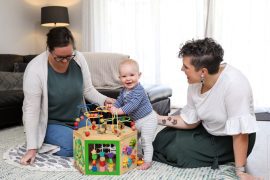By Nicole Gorring
When criticisms of sleep training circulate, there are always people who will say “but there are gentle ways to sleep train” and then give an anecdote describing how they implemented routines from birth, or offered comfort from next to the bed or whatever.
Sometimes, in an attempt to differentiate from Cry-it-Out/Controlled Crying, this is referred to as “sleep learning”.
So is sleep learning, really a thing, and is it any different to sleep training?
Well, yes and no.
If you have any education training, you’ll be familiar with a concept called the “Zone of Proximal Development”. This concept, developed by Lee Vygotsky “refers to the difference between what a learner can do without help and what he or she can achieve with guidance and encouragement from a skilled partner. Thus, the term “proximal” refers those skills that the learner is “close” to mastering.”
Vygostky recognized that at any particular developmental level there are:
(i) certain problems that a child can solve without aid,
(ii) certain problems that a child can solve with aid, and
(iii) certain problems that a child will most likely never be able to solve at this particular stage (e.g., Vygotsky, 1962).
This is one of the primary reasons why schools have curriculum. Or why maths, for example is taught sequentially. There would be no point teaching quadratic equations to someone who hasn’t learnt basic algebra, it would be beyond their zone of proximal development, and attempting to do so would simply be stressful and frustrating for everyone involved.
So what has this all got to do with sleep?
Well whilst Vygotsky was primarily concerned with cognitive learning, and problem solving, the theory applies just as well to developmental learning, or physical skills. Like the old adage, you can’t run before you walk.
As a general rule, babies do not have the ability to put themselves to sleep without adult help. So as a general rule, attempts to “teach” a baby to put themselves to sleep, result in stress and frustration, regardless of the type of approach used (eg, “sleep learning” or “sleep training”). It’s simply outside of the baby’s ability, and therefore outside of their Zone of Proximal Development.
So as a general rule, attempts to “teach” a baby to put themselves to sleep, result in stress and frustration, regardless of the type of approach used (eg, “sleep learning” or “sleep training”). It’s simply outside of the baby’s ability, and therefore outside of their Zone of Proximal Development.
But, just like in a classroom, where the curriculum is pitched to the majority, there are always going to be outliers. Those students or babies who are further ahead or behind in any particular area.
Thus for some babies, the term “sleep learning” is a legitimate name.
They have a low needs, easy going temperament, so they don’t get upset easily, and they are happy to accept comfort in numerous ways.
These are the babies you can actually put down “drowsy but awake” and they just gurgle, stretch, and go to sleep.
These are the babies who when they cry, take a long time to build up their distress, and are quite happy to just have you hold their hand and pat them to calm down.
On the other hand you have the babies with high needs, those with anxious temperaments, Koala babies.
These are the babies who cry the second you try to put them down “drowsy but awake” or to ninja roll away. The babies whose cries go from zero to panic attack in approximately 1.2 seconds.
For those babies, no “sleep learning” technique is going to be “gentle” enough for them. They aren’t going to be able to “learn” anything, because they are simply too stressed. And when we are stressed we can’t learn.











